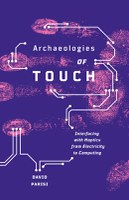ABSTRACT
 Recent deployments of haptics in wearables like smartwatches and fitness trackers has revived interest in touch's capacity to serve as a communicative channel. Since Robert Gault’s experiments attempting to route sounds—including speech and music—through the fingers in the 1920s, researchers have long suspected that, with an adequate coding system, it would be possible to use electrically-transmitted signals to communicate messages through touch. But these systems, thus far, have failed to concretize around a single standardized language or transmission mechanism. In this talk, I explore some previous examples of tactile communication systems, including Frank Geldard's vibratese (1956), CuteCircuit's Hug Shirt (2006), Apple's Taptic Engine (2015-), and Immersion Corporation’s TouchSense effects for video ads (2016-). Studying each application will help show how its designers imagined the use value of communicating through touch: what meanings did they want tactile messages to convey? What stimulus mechanisms did they employ to communicate these haptic messages? What was the relationship between the form of tactile stimuli and the content of the communicated messages? Particularly in the case of Immersion’s TouchSense, how does the addition of touch sensations transform our aesthetic experience of video and music? My final turn in the talk will be speculative, exploring the new expressive and communicative possibilities that might emerge from standardizing a new language of digital touch.
Recent deployments of haptics in wearables like smartwatches and fitness trackers has revived interest in touch's capacity to serve as a communicative channel. Since Robert Gault’s experiments attempting to route sounds—including speech and music—through the fingers in the 1920s, researchers have long suspected that, with an adequate coding system, it would be possible to use electrically-transmitted signals to communicate messages through touch. But these systems, thus far, have failed to concretize around a single standardized language or transmission mechanism. In this talk, I explore some previous examples of tactile communication systems, including Frank Geldard's vibratese (1956), CuteCircuit's Hug Shirt (2006), Apple's Taptic Engine (2015-), and Immersion Corporation’s TouchSense effects for video ads (2016-). Studying each application will help show how its designers imagined the use value of communicating through touch: what meanings did they want tactile messages to convey? What stimulus mechanisms did they employ to communicate these haptic messages? What was the relationship between the form of tactile stimuli and the content of the communicated messages? Particularly in the case of Immersion’s TouchSense, how does the addition of touch sensations transform our aesthetic experience of video and music? My final turn in the talk will be speculative, exploring the new expressive and communicative possibilities that might emerge from standardizing a new language of digital touch.
 BIOGRAPHY
BIOGRAPHY
David Parisi (PhD, NYU Media, Culture, and Communication) is an Associate Professor of Emerging Media at the College of Charleston. whose research investigates the past, present, and future of touching with digital technologies. His new book Archaeologies of Touch: Interfacing with Haptics from Electricity to Computing (University of Minnesota Press, 2018) explores the technological transformations of touch necessary for the invention of touch-based computer interfaces. Opening with an examination of touch’s role in apprehending the mysteries of eighteenth century electrical machines, and closing with an analysis of new computing technologies that digitally synthesize haptic sensations, Archaeologies of Touch traces the iterative development of a technoscientific haptics across four centuries. Along the way, he shows how electric shock, experimental psychology, cybernetics, aesthetics, telemanipulation robotics, and virtual reality each participated in a reconceptualization of touch necessary for its integration into contemporary computing technologies. His research on tactility has been featured in forums such as The Wall Street Journal, Vice, Playboy Magazine, Computer Business Review, and Public Seminar.
